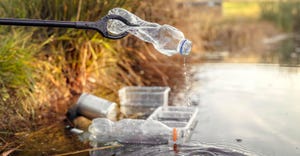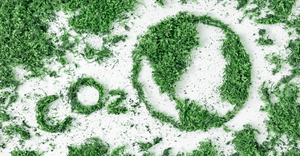Profiles in Garbage: Polyethylene Terephthalate 10745
In 2011, PET exports fell to 40 percent of the recycling market from more than half previously.
Polyethylene terephthalate is a plastic resin used to make bottles for beverages, food, and other household and consumer products. PET is a relatively new packaging resin. The PET bottle was patented in 1973. Four years later, the first PET bottle was recycled.
For many years, soft drink bottles were the biggest user of PET resin. “Custom” bottles are used for other products such as salad dressing, peanut butter and jellies. Custom bottles now account for more than half of PET containers by weight. PET is also used for film, oven trays, sheeting for cups and food trays, oven trays and other uses. This profile is limited to PET containers.
Half of all polyester carpet made in the United States is made from recycled PET bottles. Exports, however, became the largest market for PET recyclers in 2007. An increase in U.S. reclamation capacity dramatically changed this trend, with only 40 percent of PET bottles being exported in 2011. Increased consumption of water and soft drinks away from home along with continued lightweighting of PET bottles has created challenges for increasing the PET recycling rate.
PET use has reduced the size of the waste stream because PET has replaced heavier steel and glass containers.
Chaz Miller is state programs director for the National Solid Wastes Management Association, Washington. E-mail him at: [email protected].
Polyethylene Terephthalate Facts*
Generated:
2.67 million tons, or 1.1% of municipal solid waste (MSW) by weight.
17.28 pounds of PET bottles per person per year.
18 20-ounce soft drink bottles weigh one pound.
Recycled:
780,000 tons or a 29.2% recycling rate.
Industry data shows 802,000 tons or a 29.3% recycling rate in 2011.
Container deposit laws make water and soda bottles easily recyclable.
Recycled Content:
Approved by FDA, use in bottles is increasing.
Incinerated or Landfilled:
1.89 million tons or 1.1% of discarded MSW by weight.
Highly combustible, with a per-pound Btu value of 10,933, twice that of MSW.
Landfill Volume:
2.76 million cubic yards or 0.7% of landfilled MSW in 1997 were soft drink bottles.
Density:
Landfilled bottles weigh 355 pounds per cubic yard (lbs./cu.yd.).
Whole bottles have a density of 30-40 lbs./cu.yd.
Baled bottles have a density of 400-500 lbs./cu.yd.
Granulated bottles have a density of 700-750 lbs./cu.yd.
Source Reduction:
The 2-liter soft drink bottle weighs 48 grams and is 20 grams or 29% lighter than 20 years ago.
The half-liter water bottle weighs 9 grams and has lost almost twice its current weight since 1991.
The number of PET containers increased by 4% in 2011, but the weight increased by only 2.4%.
Recycling Markets:
In 2011 exports remained the largest market, but fell to 40% of the market from more than half previously.
Fiber, food and beverage bottles, and sheet and film are the primary domestic markets.
End Market Specifications:
ISRI Scrap Specifications Circular 2012: Guidelines for Plastic Scrap: P-2012 includes PET bottle specs. Contamination is limited to 2%.
Do not store outside for more than six months unless covered with UV resistant materials.
Other plastic resins, in particular PVC, OPS, PETG, and bio-based resins such as PLA, are PET contaminants.
Sources:
“Municipal Solid Waste Generation, Recycling and Disposal in the United States: 2010 Facts and Figures,” U.S. EPA, Office of Solid Waste, www.epa.gov/osw
“Measurement Standards and Reporting Guidelines,” National Recycling Coalition, Washington, www.nrc-recycle.org
National Association for PET Container Resources. www.napcor.com
Scrap Specifications Circular 2012, Institute of Scrap Recycling Industries, Washington, www.isri.org
*Data is from 2010 EPA estimates, except where noted.
About the Author
You May Also Like




